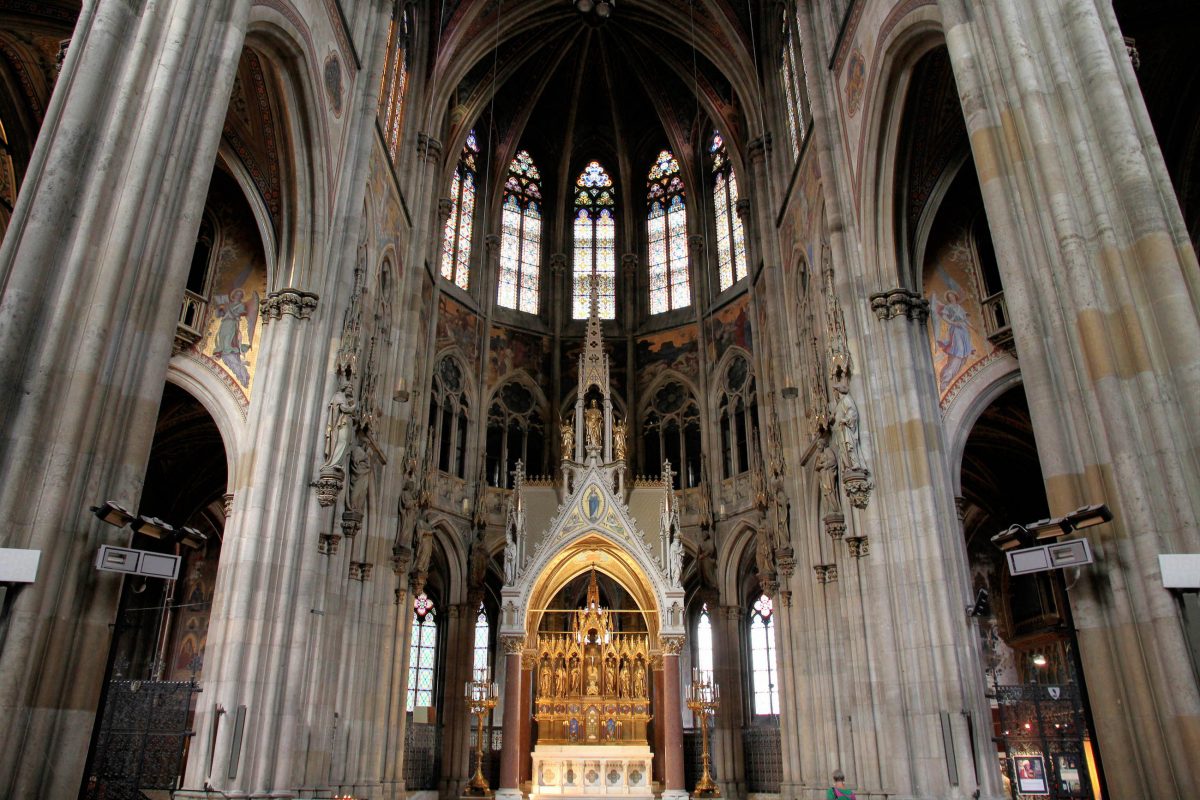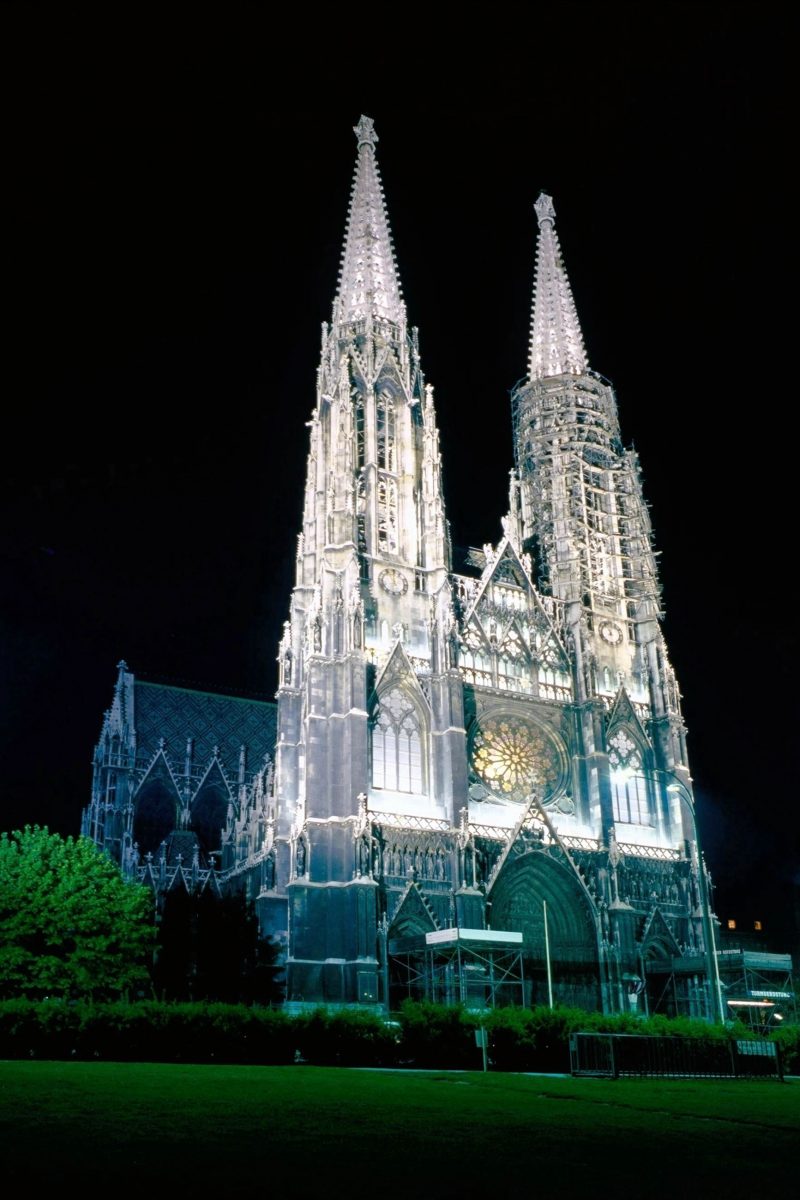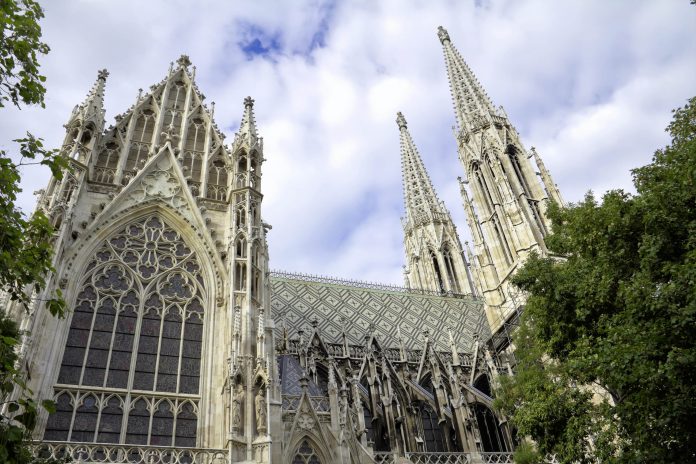Die Votivkirche in Wien thront als neugotisches Meisterwerk an der Station Schottentor neben der Wiener Haupt-Uni und ist mit ihren imposanten Türmen die zweithöchste Kirche der Stadt.
Die beeindruckende Votivkirche an der Ringstraße gilt als Höhepunkt der historischen Kirchenbauten von Wien und zählt auch im weltweiten Vergleich zu den bedeutendsten und schönsten neugotischen Sakralbauten. Auch als Ringstraßendom bezeichnet, thront die römisch-katholische Prachtkirche unübersehbar im Bezirk Alsergrund neben dem Hauptgebäude der Universität Wien und ist über die U-Bahn-Station „Schottentor“ zu erreichen.
Inhaltsverzeichnis
BILDER: Votivkirche in Wien
Fotogalerie: Votivkirche in Wien
Die Einweihung der prachtvollen Kirche im April 1854 war der Auftakt zur Stadterweiterung, im Zuge derer in den darauffolgenden Jahren prächtige Bauten wie das Parlament, das Kunst- und Naturhistorische Museum oder die Staatsoper an der Ringstraße entstanden. Mit ihren beiden 99 Meter hohen Türmen ist die dreischiffige Kathedrale hinter dem 136m hohen Stephansdom die zweithöchste Kirche von Wien.
Eindrucksvolle Ausstattung der Votivkirche

Die Wiener Votivkirche ist mit ihrer spektakulären neugotischen Fassade nicht nur von außen imposant anzusehen, sondern kann sich auch von innen sehen lassen. Das monumentale Kirchenschiff mit unzähligen Säulen aus reicht geschmücktem Marmor und Kalkstein wird von 78 bemalten Glasfenstern in mystisches Licht getaucht.
Der Hochaltar wurde zum Teil von Papst Pius IX. gewidmet, in Rom gefertigt und ruht auf einem Altartisch aus Laaser Marmor und ägyptischem Alabaster. Die kunstvollen Kapellen und Altäre der Votivkirche verdienen es mit ihren meisterhaften Details alle, genauer betrachtet zu werden.

Kosmopolitische Votivkirche
Die Votivkirche ist nicht nur aufgrund ihrer baulichen Faszination bedeutend, sondern gilt auch als kosmopolitischstes Gotteshaus der Stadt, da sie viele fremdsprachige Gemeinden in Wien beherbergt.Ein Seitenaltar ist beispielsweise der Heiligen Muttergottes von Guadalupe in Mexiko gewidmet.
Die sonntägliche Messe um 11:15 Uhr findet außerdem in mehreren Sprachen statt.Zweimal im Monat werden eigene Kindergottesdienst in Deutsch und Englisch abgehalten.
Entstehung der Votivkirche in Wien
Die Ursprungsidee für ihre Entstehung hat die prächtige Votivkirche dem Erzherzog Ferdinand Maximilian zu verdanken. Kurz davor, am 18. Februar 1853, wurde das vom Schneidergesellen János Libényi geplante Attentat auf seinen Bruder und Kaiser, Franz Joseph I. vereitelt.
Folglich rief der spätere Kaiser von Mexiko, der auch das Schloss Miramare bei Triest in Italien errichten ließ, das Volk zu Spenden für eine Kirche auf, die „zum Dank für die Errettung Seiner Majestät“ gebaut werden sollte.
Daher hat die Kirche auch ihren Namen, denn als Votivgabe wird ein symbolisches Opfer zum Dank für die Errettung aus einer Notlage bezeichnet.
Dem dankbaren Volk sei Dank, es wurden ausreichend Spendengelder aufgetrieben. Den Architektenwettbewerb im Jahr 1854 gewann der damals erst 26jährige Heinrich Ferstel, dessen Entwurf 74 weitere aus Österreich, Deutschland, England und Frankreich ausstach.
Zwei Jahre später folgte die Grundsteinlegung und nach einer Bauzeit von 26 Jahren wurde die Votivkirche am 24. April 1879 eingeweiht – auf den Tag genau zur Silberhochzeit des Kaiserpaares Franz Joseph I. und Elisabeth.
Renovierung nach dem Zweiten Weltkrieg

Nach dem Zweiten Weltkrieg wurde die Votivkirche schwer beschädigt und fast alle wunderbaren Glasfenster gingen zu Bruch. Aufgrund fehlender finanzieller Mittel wurde die Votivkirche erst in den 1960er-Jahren renoviert. Viele Originalzeichnungen waren jedoch nicht mehr vorhanden. Aus diesem Grund wurden vor allem die Buntglasfenster zum Großteil völlig neu gestaltet. Heute finden wieder jeden Samstag und Sonntag Heilige Messen statt.
Weiterführende Links:





